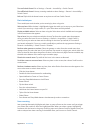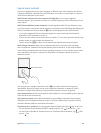
D
151
Safety, Handling, & Support
Important safety information
WARNING: Failure to follow these safety instructions could result in re, electric shock, or other
injuries, or damage to iPhone or other property. Read all the safety information below before
using iPhone.
Handling Handle iPhone with care. It is made of metal, glass, and plastic and has sensitive
electronic components inside. iPhone can be damaged if dropped, burned, punctured, or
crushed, or if it comes in contact with liquid. Don’t use a damaged iPhone, such as one with a
cracked screen, as it may cause injury. If you’re concerned about scratching the surface of iPhone,
consider using a case or cover.
Repairing Don’t open iPhone and don’t attempt to repair iPhone by yourself. Disassembling
iPhone may damage it or may cause injury to you. If iPhone is damaged, malfunctions, or comes
in contact with liquid, contact Apple or an Apple Authorized Service Provider. You can nd more
information about getting service at www.apple.com/support/iphone/service/faq.
Battery Don’t attempt to replace the iPhone battery yourself—you may damage the battery,
which could cause overheating and injury. The lithium-ion battery in iPhone should be replaced
only by Apple or an Apple Authorized Service Provider, and must be recycled or disposed of
separately from household waste. Don’t incinerate the battery. For information about battery
recycling and replacement, see www.apple.com/batteries.
Distraction Using iPhone in some circumstances can distract you and may cause a dangerous
situation. Observe rules that prohibit or restrict the use of mobile phones or headphones (for
example, avoid texting while driving a car or using headphones while riding a bicycle).
Navigation Maps, directions, Flyover, and location-based apps depend on data services.
Charging Charge iPhone with the included USB cable and power adapter, or with other third-
party “Made for iPhone” cables and power adapters that are compatible with USB 2.0, or power
adapters compliant with one or more of the following standards: EN 301489-34, IEC 62684,
YD/T 1591-2009, CNS 15285, ITU L.1000, or another applicable mobile phone power adapter
interoperability standard. An iPhone Micro USB Adapter (available separately in some areas) or
other adapter may be needed to connect iPhone to some compatible power adapters. Using
damaged cables or chargers, or charging when moisture is present, can cause electric shock.
When you use the Apple USB Power Adapter to charge iPhone, make sure that the AC plug or AC
power cord is fully inserted into the adapter before you plug it into a power outlet.
Note: Only micro USB power adapters in certain regions that comply with applicable
mobile phone power adapter interoperability standards are compatible. Please contact the
power adapter manufacturer to nd out if your micro USB power adapter complies with
these standards.
Appendix


















